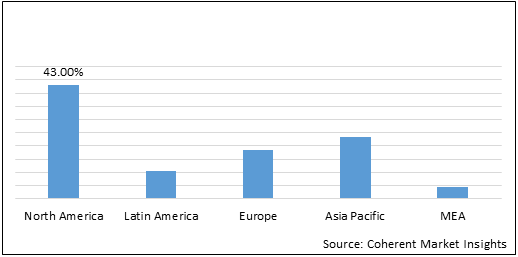Market Overview
The infrared light spectrum is divided into four types: near-infrared spectral region (IR-A), short-wavelength infrared (SWIR, IR-B), long-wavelength infrared (LWIR, IR-C), and mid-infrared (mid-wave infrared, (IR-C, MWIR). Among these, mid-infrared type ranges from 3 to 8 µm due to which various gases and liquids such as oxygen and water show high absorption in this spectrum. As many gases pose high absorption nature in this region ( 3-8 µm), the mid-IR sensor is used in wide range of applications, which include imaging, medical diagnostics, industrial process controls, remote gas leak detection, fire detection, real-time combustion control, pollution monitoring, and others.
The global mid-IR sensors market was valued at US$ 9.8 Bn in 2019 and is expected to exhibit a CAGR of 35.7% during the forecast period (2020 - 2027).
Market Dynamics- Drivers
Increasing demand for thermal imager quipped with mid-IR sensor in space exploration industry is expected to drive growth of the global mid-IR sensors market during the forecast period
A thermal imaging camera or infrared camera is one of the major applications of mid-IR sensors. Thermal imagers are a non-contact type thermal camera that provides visual information on display using thermal radiation. Thermal imagers are rapidly adopted in the space exploration industries for image sensing and data mining. For instance, according to Jet Propulsion Laboratory (JPL), a part of the U.S.-based space exploration agency NASA, is launching James Webb Space Telescope in 2021. In this telescope, NASA is using the Mid-Infrared Instrument (MIRI). This instrument will help the telescope to capture image stars and galaxies in infrared light. Also, this data will be analyzed for the evolution of the universe and star formation. Moreover, the space exploration industry is rapidly growing. According to Coherent Market Insights’ analysis, space exploration industry is expected to reach around 1.2 trillion by 2040. Thus, increasing demand for thermal imagers equipped with mid-IR sensors in the space exploration industry is expected to drive growth of the global mid-IR sensors market during the forecast period.
Statistics:
North America held dominant position in the global mid-IR sensors market in 2019, accounting for 43% share in terms of value, followed by Europe and Asia Pacific, respectively.
Figure 1: Global Mid-IR Sensors Market Share (%) in Terms of value, By Region, 2019
To learn more about this report, Download Free Sample
Market Restraints
Low scalability and high manufacturing cost are expected to hamper the global mid-IR sensors market growth during the forecast period
Various chemicals and biological substances can be accurately detected by mid-IR sensors, which is a major factor driving the mid-IR market growth. However, detection of each and every substance requires a specific light source and detector, which ultimately increases end-product cost. The demand for mid-IR sensors is increasing in the material and chemical detection market, however, low scalability and high manufacturing cost are expected to hamper growth of the global mid-IR sensors market over the forecast period.
Market Opportunities
An increase in demand for low-cost mid-IR sensors for consumer products is expected to create lucrative growth opportunities for players operating in the global mid-IR sensors market
Earlier, low-cost optical sensing technology was mainly limited to near-infrared (IR) and visible wavelengths; however, currently, there is an increase in demand for mid-IR wavelengths (2.5–25 µm) equipped with low-cost optical sensing technology for applications including thermal imaging spectroscopy, air quality monitoring, and consumer products. Among these applications, use of mid-IR sensors in consumer products is expected to provide lucrative growth opportunities to the key players. Mid-IR sensors can be used for composition analysis of edible oils, sugar and salt monitoring of food items, and other applications. According to Coherent Market Insights’ analysis, India consumer products registered a growth of 13.3% in the year 2018-2019 and it is expected to increase over the forecast period. Thus, an increase in demand for low-cost mid-IR sensors for consumer products is expected to create lucrative growth opportunities for players operating in the global mid-IR sensors market.
Figure 2: Global Mid-IR Sensors Market Value (US$ Bn), 2017 - 2027

To learn more about this report, Download Free Sample
The global mid-IR sensors market was valued at US$ 9.8Bn in 2019 and is projected to reach a value of US$ 112.4 Bn by 2027 at a CAGR of 35.7 % between 2020 and 2027.
Competitive Landscape
Key players operating in the global mid-IR sensors market include Daylight Solutions, Inc., Structured Materials Industries, Inc., Maxion Technologies, SenseAir, Sofradir, Cascade Technologies, Inc., AdTech Optics, Inc., Block Engineering, LLC, HAMAMATSU PHOTONICS K.K., M-Squared Lasers Limited, Opto-Knowledge Systems, Inc., CMLaser Technologies Inc., Genia Photonics, IPG Photonics Corporation, Coherent, Inc., EKSPLA, Northrop Grumman Corporation, Quantum Composers, Inc., Coractive High-Tech Inc., and others.
These key market players are focusing on strategic expansions to meet the increasing consumer demand.
Key Developments
Share
Share
Missing comfort of reading report in your local language? Find your preferred language :
Transform your Strategy with Exclusive Trending Reports :
Frequently Asked Questions
Select a License Type
Joining thousands of companies around the world committed to making the Excellent Business Solutions.
View All Our Clients